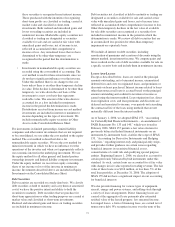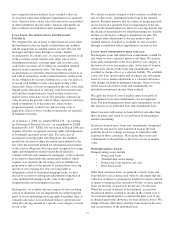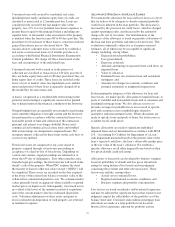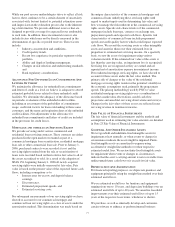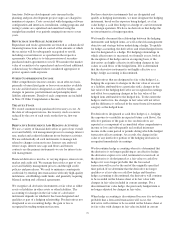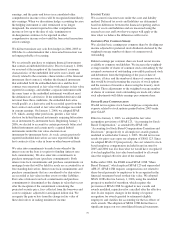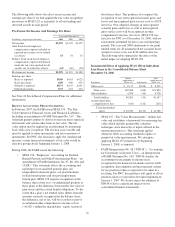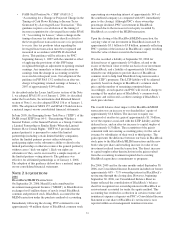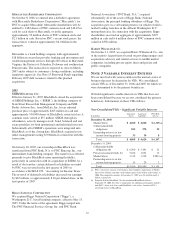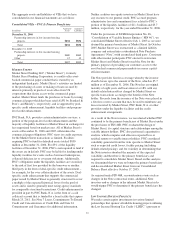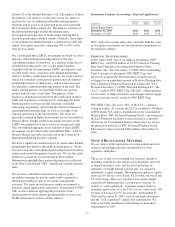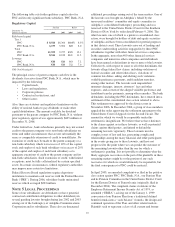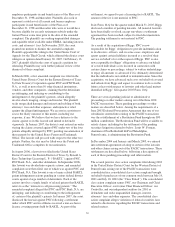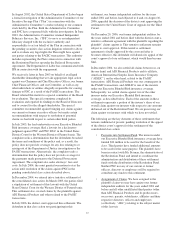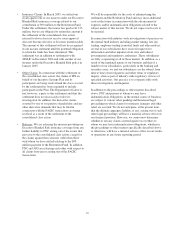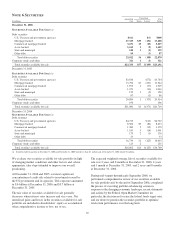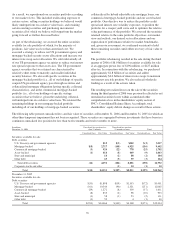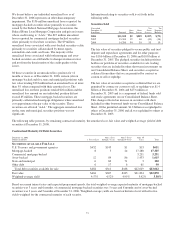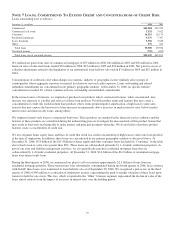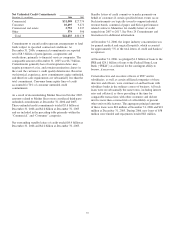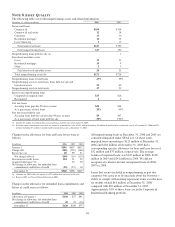PNC Bank 2006 Annual Report Download - page 94
Download and view the complete annual report
Please find page 94 of the 2006 PNC Bank annual report below. You can navigate through the pages in the report by either clicking on the pages listed below, or by using the keyword search tool below to find specific information within the annual report.
Section 42 of the Internal Revenue Code. The purpose of these
investments is to achieve a satisfactory return on capital, to
facilitate the sale of additional affordable housing product
offerings and to assist us in achieving goals associated with
the Community Reinvestment Act. The primary activities of
the limited partnerships include the identification,
development and operation of multi-family housing that is
leased to qualifying residential tenants. Generally, these types
of investments are funded through a combination of debt and
equity, with equity typically comprising 30% to 60% of the
total project capital.
We consolidated those LIHTC investments in which we own a
majority of the limited partnership interests. We also
consolidated entities in which we, as a national syndicator of
affordable housing equity, serve as the general partner
(together with the aforementioned LIHTC investments), and
no other entity owns a majority of the limited partnership
interests. In these syndication transactions, we create funds in
which our subsidiary is the general partner and sells limited
partnership interests to third parties, and in some cases may
also purchase a limited partnership interest in the fund. The
fund’s limited partners can generally remove the general
partner without cause at any time. The purpose of this
business is to generate income from the syndication of these
funds and to generate servicing fees by managing the funds.
General partner activities include selecting, evaluating,
structuring, negotiating, and closing the fund investments in
operating limited partnerships, as well as oversight of the
ongoing operations of the fund portfolio. The assets are
primarily included in Equity Investments on our Consolidated
Balance Sheet. Neither creditors nor equity investors in the
LIHTC investments have any recourse to our general credit.
The consolidated aggregate assets and debt of these LIHTC
investments are provided in the Consolidated VIEs – PNC Is
Primary Beneficiary table and reflected in the Corporate &
Institutional Banking business segment.
We have a significant variable interest in certain other limited
partnerships that sponsor affordable housing projects. We do
not own a majority of the limited partnership interests in these
entities and are not the primary beneficiary. We use the equity
method to account for our investment in these entities.
Information regarding these partnership interests is reflected
in the Non-Consolidated VIEs – Significant Variable Interests
table.
We also have subsidiaries that invest in and act as the
investment manager for private equity funds organized as
limited partnerships as part of our equity management
activities. The funds invest in private equity investments to
generate capital appreciation and profits. As permitted by FIN
46R, we have deferred applying the provisions of the
interpretation for these entities pending further action by the
FASB. Information on these entities follows:
Investment Company Accounting – Deferred Application
In millions
Aggregate
Assets
Aggregate
Equity
PNC Risk
of Loss
Private Equity Funds
December 31, 2006 $102 $102 $104
December 31, 2005 $109 $109 $ 35
PNC’s risk of loss in the tables above includes both the value
of our equity investments and any unfunded commitments to
the respective entities.
P
ERPETUAL
T
RUST
S
ECURITIES
In December 2006, one of our indirect subsidiaries, PNC
REIT Corp., sold $500 million of 6.517% Fixed-to-Floating
Rate Non-Cumulative Exchangeable Perpetual Trust
Securities (the “Trust Securities”) of PNC Preferred Funding
Trust I, in a private placement. PNC REIT Corp. had
previously acquired the Trust Securities from the trust in
exchange for an equivalent amount of Fixed-to-Floating Rate
Non-Cumulative Perpetual Preferred Securities (the “LLC
Preferred Securities”), of PNC Preferred Funding LLC, (the
“LLC”), held by PNC REIT Corp. The LLC’s initial material
assets consist of indirect interests in mortgages and mortgage-
related assets previously owned by PNC REIT Corp.
PNC REIT Corp. also owns 100% of the LLC’s common
voting securities. As a result, the LLC is an indirect subsidiary
of PNC Bank, N.A. and is consolidated on our Consolidated
Balance Sheet. PNC Preferred Funding Trust I’s investment in
the LLC Preferred Securities is characterized as a minority
interest on our Consolidated Balance Sheet since we are not
the primary beneficiary of PNC Preferred Funding Trust I.
This minority interest totaled $490 million at December 31,
2006.
N
OTE
4R
EGULATORY
M
ATTERS
We are subject to the regulations of certain federal and state
agencies and undergo periodic examinations by such
regulatory authorities.
The access to and cost of funding new business initiatives
including acquisitions, the ability to pay dividends, the level
of deposit insurance costs, and the level and nature of
regulatory oversight depend, in large part, on a financial
institution’s capital strength. The minimum regulatory capital
ratios are 4% for tier 1 risk-based, 8% for total risk-based and
4% for leverage. However, regulators may require higher
capital levels when particular circumstances warrant. To
qualify as “well capitalized,” regulators require banks to
maintain capital ratios of at least 6% for tier 1 risk-based, 10%
for total risk-based and 5% for leverage. At December 31,
2006 and December 31, 2005, each of our bank subsidiaries
met the “well capitalized” capital ratio requirements. We
believe our bank subsidiaries will continue to meet these
requirements in 2007.
84


